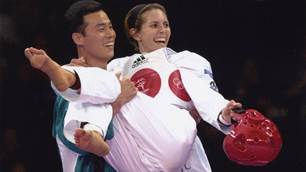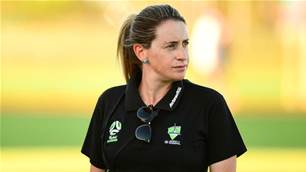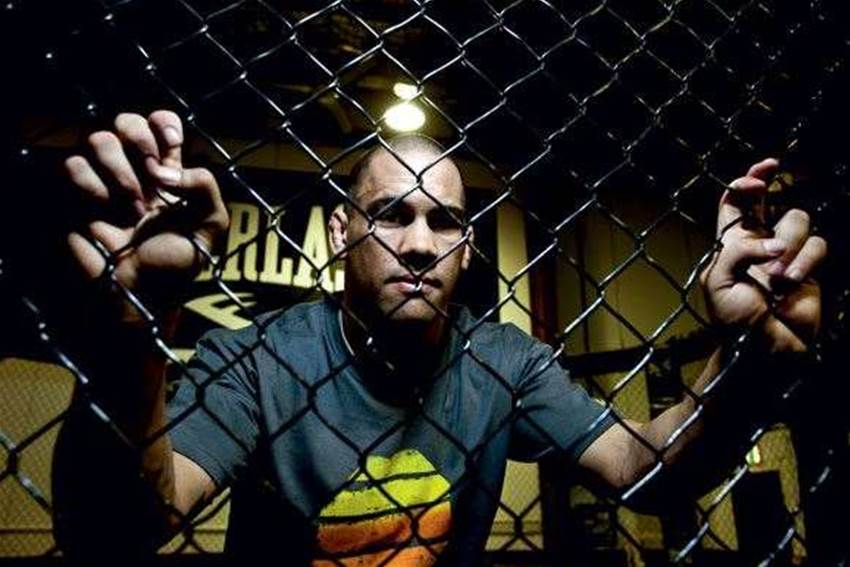His 19 professional Mixed Martial Arts (MMA) fights have yielded 14 victories, seven of them by fistic knockout.
His 19 professional Mixed Martial Arts (MMA) fights have yielded 14 victories, seven of them by fistic knockout...
With his shaven head, his mountainous neck and his inked arms, James Te Huna is the standover man from central casting. Put him in the octagon and he plays to character. He lists his most potent weapons as his takedowns and his ground-and-pound. For those unfamiliar with UFC cant, this means he likes dumping fighters on their backs, pinning their arms, then shouldering punches onto their unprotected faces. Brutal but effective. His 19 professional Mixed Martial Arts (MMA) fights have yielded 14 victories, seven of them by fistic knockout.
 James Te Huna Boxing Ring Images: Warren Clarke
James Te Huna Boxing Ring Images: Warren ClarkeOut of the octagon, however, Te Huna is a different man. Born and raised across the ditch, he carries those typical Kiwi traits: he’s got a ready laugh and he loves a chat. He moved to Australia when he was 16 and promptly earned a crust laying bricks. He figured there had to be an easier way. So he turned his hand to professional fighting. Sure, it’s a tad more dangerous but the pay packets are a little thicker, particularly now he’s broken into the rarefied atmosphere of the UFC
Early days
“As young kids, me and my brother loved Bruce Lee movies. So I started going to a karate gym when I was eight, then I started going to a boxing gym when I was 13. I was the smallest and skinniest kid at my school in Darfield – I wanted to look intimidating, wanted kids to stop picking on me… So I started boxing, nothing serious, just a couple of nights a week after school. I had a couple of amateur fights. Then I moved to Australia and that’s when I started kickboxing. Again, had a couple of amateur fights – my record was pretty mixed, couple of wins, couple of losses. But I was always interested in martial arts – I wasn’t going to leave the sport. And then my brother, Tama, brought home some UFC videos. And we were just glued to it. So we found a jujitsu coach in the local area. Couple of months later, I had my first MMA fight up in Queensland. Quick turnaround! But I just loved MMA. It had everything. When I boxed I’d train for a few months then I’d start getting restless, start looking around. I couldn’t stick to one style. But mixed martial arts had everything. It was for me.”
A mug’s game?
“MMA is definitely not a thug’s game. It’s a mixture of four current Olympic sports: boxing, taekwondo, wrestling and judo. We use all those disciplines inside the cage. Obviously, there are a lot of tactics and they always depend on the strengths of the guy you’re fighting. He might be strong on his feet, might be strong on the ground, might be a slow starter, might be a fast starter. You’ve got to study your opponent and come up with a game plan. But you also have to be aware that your game plan can change just like that. There have been fights where I’ve gone in with the game plan to stay on my feet because I know the other bloke’s a strong wrestler. But then I get out there and in the first 30 seconds he’s hurt me on my feet and I’ve had to change my whole approach. For the previous three months, I’ve been training to stay on my feet – suddenly got to throw all that out and try and get him on the ground. You’ve got to be aware in the cage, got to be flexible.”
Takedowns
“Wrestling and MMA wrestling are two different things. I’ve got a mate called Igor Praporshchikov who’s a freestyle Olympic wrestler. Now if I do straight wrestling with him, he hammers me. But when we bring in punches, it changes the game. With my boxing background, I can see gaps opening up, so I’ll get some punches in his face, then I’ll dive for the legs. It’s all about transitioning from boxing, to takedowns, to wrestling. You’ve got to set up your shots then go for the legs, get him on the floor. It’s all about that fast transition. You see a lot of guys who are strong boxers and good wrestlers but they’re not good at transitioning the two. That’s where I’m good. I can hit them with shots – boom-boom-boom – then take them down. To train for that, you just have to drill specific movements with a partner. I normally break the drills down. So the first drill will focus on my speed, doing the movements on a guy who’s not defending. The next will focus on my strength, so I’ll work with a heavier person, lifting him off the ground. The next will focus on timing, so we’ll be moving around, with my partner throwing shadow punches at me. The last one will be live, full contact.“
Related Articles

Garriock ready to put the boot into new role

Sydney Olympic hero reminisces about her golden moment













